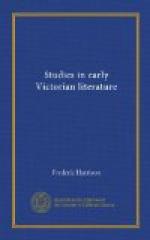The art of romance, in the widest and loftiest sense of the term, is even yet in its infancy. Ancient literature, mediaeval literature, knew nothing of it. Nor indeed did modern literature entirely conceive it in all its fulness until the days of Le Sage, Richardson, Fielding, and Goldsmith. Nay, we may say that its power was not quite revealed before Scott, Goethe, Manzoni, Jane Austen, Balzac, Thackeray, Dickens, and George Sand. Its subtlety, its flexibility, its capacity for analytic research, its variety of range, and facility for reaching all hearts and all minds—all this is simply incalculable. And we may be sure that the star of romance has not yet reached its zenith. It is the art of the future—and an art wherein women are quite as likely to reign as men. It would be treason to Art to pretend that George Eliot came near to such perfection. But she had certain qualities that none of her predecessors had quite possessed, and she strove for an ideal which may one day become something more than a dream—a dream that as yet eludes and escapes from the mind as it struggles to grasp it and to fix it.



